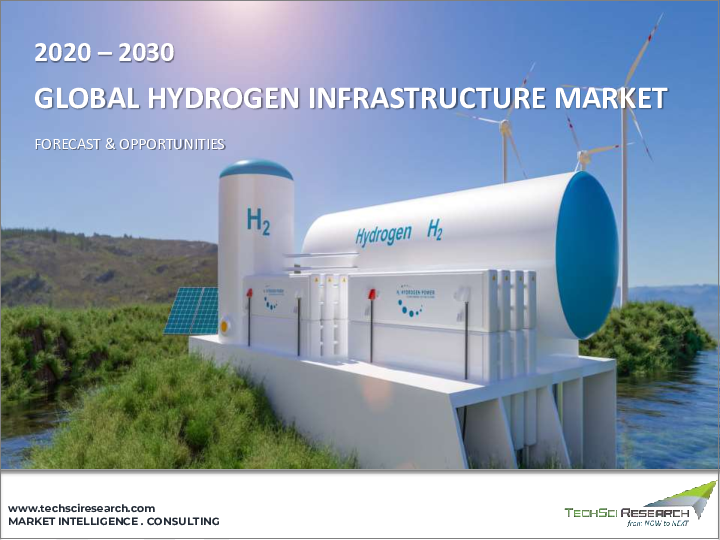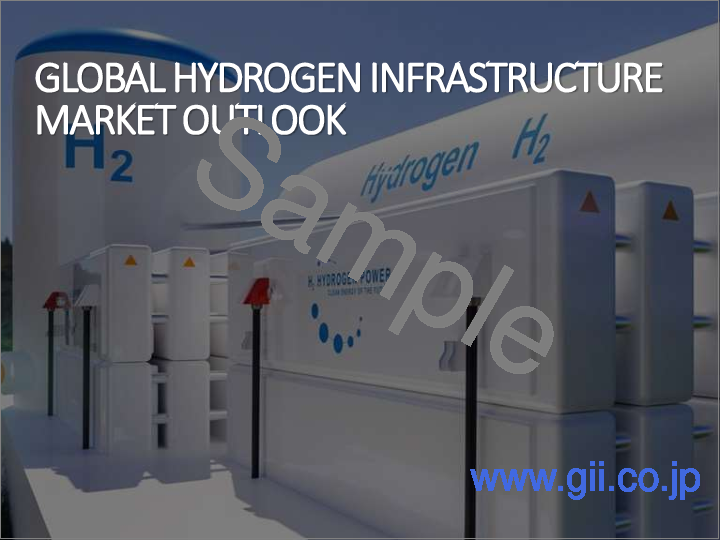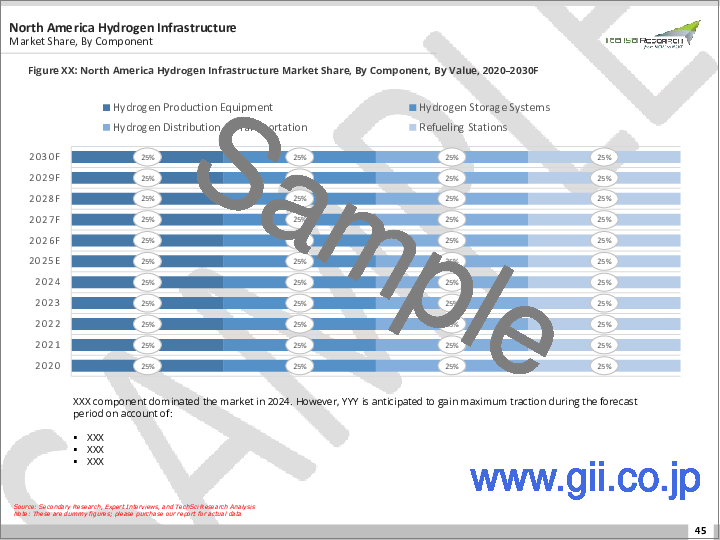|
|
市場調査レポート
商品コード
1763948
水素インフラ市場- 世界の産業規模、シェア、動向、機会、予測、製品タイプ別、エンドユーザー別、供給源別、地域別セグメント、競合、2020年~2030年Hydrogen Infrastructure Market - Global Industry Size, Share, Trends, Opportunity, and Forecast, Segmented By Product Type, By End User, By Source, By Region, and By Competition, 2020-2030F |
||||||
カスタマイズ可能
|
|||||||
| 水素インフラ市場- 世界の産業規模、シェア、動向、機会、予測、製品タイプ別、エンドユーザー別、供給源別、地域別セグメント、競合、2020年~2030年 |
|
出版日: 2025年06月30日
発行: TechSci Research
ページ情報: 英文 185 Pages
納期: 2~3営業日
|
全表示
- 概要
- 目次
水素インフラの世界市場規模は、2024年に61億7,000万米ドルとなり、2030年には180億5,000万米ドルに達すると予測され、予測期間中のCAGRは19.41%で成長すると予測されます。
水素はクリーンなエネルギーキャリアとして、特に重工業、輸送、発電など脱炭素化が困難な分野で勢いを増しており、市場はダイナミックな成長を遂げています。再生可能エネルギーによる電気分解で生成されるグリーン水素は、ネットゼロ目標達成の可能性から大きな注目を集めています。世界各国の政府は、資金援助、戦略的ロードマップ、規制的インセンティブを通じて水素経済を支援しています。その結果、水素製造、貯蔵、輸送、燃料補給のためのインフラは急速に拡大しています。サウジアラビアのNEOMグリーン水素プロジェクトのような大規模な取り組みや、欧州、北米、アジア太平洋のような地域全体での水素充填ステーションの広範な展開は、この分野の開発ペースが加速していることを例証しています。
| 市場概要 | |
|---|---|
| 予測期間 | 2026-2030 |
| 市場規模:2024年 | 61億7,000万米ドル |
| 市場規模:2030年 | 180億5,000万米ドル |
| CAGR:2025年~2030年 | 19.41% |
| 急成長セグメント | 水素貯蔵 |
| 最大市場 | 北米 |
市場促進要因
政府の政策とインセンティブ
主な市場課題
高い設備投資要件
主要市場動向
水素燃料補給インフラの拡大
目次
第1章 概要
第2章 調査手法
第3章 エグゼクティブサマリー
第4章 顧客の声
第5章 世界の水素インフラ市場展望
- 市場規模・予測
- 金額別
- 市場シェア・予測
- 製品タイプ別(水素製造、水素貯蔵、水素分配、水素供給)
- エンドユーザー別(産業、輸送、発電、商業および住宅)
- 供給源別(ブルー水素、グリーン水素、グレー水素)
- 地域別(北米、欧州、南米、中東・アフリカ、アジア太平洋)
- 企業別(2024)
- 市場マップ
第6章 北米の水素インフラ市場展望
- 市場規模・予測
- 市場シェア・予測
- 北米:国別分析
- 米国
- カナダ
- メキシコ
第7章 欧州の水素インフラ市場展望
- 市場規模・予測
- 市場シェア・予測
- 欧州:国別分析
- ドイツ
- フランス
- 英国
- イタリア
- スペイン
第8章 アジア太平洋地域の水素インフラ市場展望
- 市場規模・予測
- 市場シェア・予測
- アジア太平洋地域:国別分析
- 中国
- インド
- 日本
- 韓国
- オーストラリア
第9章 中東・アフリカの水素インフラ市場展望
- 市場規模・予測
- 市場シェア・予測
- 中東・アフリカ:国別分析
- サウジアラビア
- アラブ首長国連邦
- 南アフリカ
第10章 南米の水素インフラ市場展望
- 市場規模・予測
- 市場シェア・予測
- 南米:国別分析
- ブラジル
- コロンビア
- アルゼンチン
第11章 市場力学
- 促進要因
- 課題
第12章 市場動向と発展
- 合併と買収
- 製品上市
- 最近の動向
第13章 企業プロファイル
- Linde plc
- Air Liquide
- Air Products & Chemicals
- Uniper SE
- McPhy Energy S.A.
- Xebec Adsorption
- ITM Power PLC
- Nel ASA
- Siemens Energy
- Cummins Inc.
第14章 戦略的提言
第15章 調査会社について・免責事項
The Global Hydrogen Infrastructure Market was valued at USD 6.17 Billion in 2024 and is projected to reach USD 18.05 Billion by 2030, growing at a CAGR of 19.41% during the forecast period. The market is experiencing dynamic growth as hydrogen gains momentum as a clean energy carrier, particularly in sectors that are challenging to decarbonize such as heavy industry, transport, and power generation. Green hydrogen, generated via renewable-powered electrolysis, is drawing significant attention due to its potential in achieving net-zero targets. Governments worldwide are backing the hydrogen economy through funding, strategic roadmaps, and regulatory incentives. As a result, infrastructure for hydrogen production, storage, transportation, and refueling is expanding rapidly. Large-scale initiatives such as the NEOM green hydrogen project in Saudi Arabia and widespread deployment of hydrogen refueling stations across regions like Europe, North America, and Asia-Pacific exemplify the accelerating pace of development in this sector.
| Market Overview | |
|---|---|
| Forecast Period | 2026-2030 |
| Market Size 2024 | USD 6.17 Billion |
| Market Size 2030 | USD 18.05 Billion |
| CAGR 2025-2030 | 19.41% |
| Fastest Growing Segment | Hydrogen Storage |
| Largest Market | North America |
Key Market Drivers
Government Policies & Incentives
Supportive government policies and financial incentives are major catalysts for hydrogen infrastructure development. The United States, for example, has allocated USD 9.5 billion for clean hydrogen under its infrastructure legislation, including tax credits of up to USD 3/kg for hydrogen production. Germany committed Euro 9 billion to its National Hydrogen Strategy and surpassed 100 hydrogen refueling stations by 2023. France plans to invest Euro 7 billion in hydrogen infrastructure by 2030, primarily for industrial decarbonization. South Korea is targeting 310 hydrogen stations by 2030, underpinned by USD 300 million in annual subsidies. Similarly, Japan is aiming for 900 stations and 800,000 fuel cell vehicles by the same year. These policy frameworks are enabling hydrogen deployment by improving project economics, reducing investment risk, and building a foundation for long-term industry growth.
Key Market Challenges
High Capital Investment Requirements
Developing hydrogen infrastructure requires substantial capital expenditure, creating a significant barrier to widespread adoption. The cost of electrolyzers, essential for green hydrogen production, can range from USD 500 to USD 1,200 per kW. Refueling stations also entail high setup costs, typically between USD 1 million and USD 4 million per site-much higher than conventional fueling alternatives. Additionally, hydrogen storage and transportation infrastructure involves complex and expensive engineering, especially for high-pressure or liquefied systems. Building dedicated hydrogen pipelines or transport vessels adds further capital intensity. The absence of stable demand or long-term offtake agreements in early-stage projects increases investor risk. Financing challenges are more acute in developing economies, where public funding is limited. Without comprehensive support mechanisms, including subsidies and de-risking measures, many projects face delays or cancellation. This capital-heavy nature of hydrogen infrastructure hinders market scalability and deters new entrants.
Key Market Trends
Expansion of Hydrogen Refueling Infrastructure
A prominent trend in the hydrogen infrastructure market is the growing deployment of hydrogen refueling stations (HRS) to support fuel cell electric vehicles (FCEVs). By 2023, the global number of HRS exceeded 920, up from around 330 in 2018. Japan leads globally with over 160 operational stations and aims for 900 by 2030. Germany has surpassed 100 public stations under its H2 Mobility initiative, while South Korea plans to build 310 stations by 2030. California's roadmap targets 200 public stations by 2025, and China had over 350 operational stations by the end of 2023. These networks are crucial for FCEV deployment, particularly for commercial fleets requiring fast refueling and extended range. Modern stations are incorporating 700-bar and 350-bar systems to serve both passenger and heavy-duty vehicles. In addition, many sites now feature on-site electrolysis for localized green hydrogen production. Enhanced digital integration, such as automated dispensing, remote monitoring, and mobile app connectivity, is also improving station efficiency and user accessibility. As FCEV manufacturers scale their offerings, the build-out of refueling infrastructure is expected to accelerate further, especially along freight corridors and urban transport networks.
Key Market Players
- Linde plc
- Air Liquide
- Air Products & Chemicals
- Uniper SE
- McPhy Energy S.A.
- Xebec Adsorption
- ITM Power PLC
- Nel ASA
- Siemens Energy
- Cummins Inc.
Report Scope:
In this report, the Global Hydrogen Infrastructure Market has been segmented into the following categories, in addition to the industry trends which have also been detailed below:
Hydrogen Infrastructure Market, By Product Type:
- Hydrogen Production
- Hydrogen Storage
- Hydrogen Distribution
- Hydrogen Dispensing
Hydrogen Infrastructure Market, By End User:
- Industrial
- Transportation
- Power Generation
- Commercial & Residential
Hydrogen Infrastructure Market, By Source:
- Blue Hydrogen
- Green Hydrogen
- Grey Hydrogen
Hydrogen Infrastructure Market, By Region:
- North America
- United States
- Canada
- Mexico
- Europe
- Germany
- France
- United Kingdom
- Italy
- Spain
- South America
- Brazil
- Argentina
- Colombia
- Asia-Pacific
- China
- India
- Japan
- South Korea
- Australia
- Middle East & Africa
- Saudi Arabia
- UAE
- South Africa
Competitive Landscape
Company Profiles: Detailed analysis of the major companies present in the Global Hydrogen Infrastructure Market.
Available Customizations:
Global Hydrogen Infrastructure Market report with the given market data, TechSci Research offers customizations according to a company's specific needs. The following customization options are available for the report:
Company Information
- Detailed analysis and profiling of additional market players (up to five).
Table of Contents
1. Product Overview
- 1.1. Market Definition
- 1.2. Scope of the Market
- 1.2.1. Markets Covered
- 1.2.2. Years Considered for Study
- 1.2.3. Key Market Segmentations
2. Research Methodology
- 2.1. Objective of the Study
- 2.2. Baseline Methodology
- 2.3. Key Industry Partners
- 2.4. Major Association and Secondary Applications
- 2.5. Forecasting Methodology
- 2.6. Data Triangulation & Validation
- 2.7. Assumptions and Limitations
3. Executive Summary
- 3.1. Overview of the Market
- 3.2. Overview of Key Market Segmentations
- 3.3. Overview of Key Market Players
- 3.4. Overview of Key Regions/Countries
- 3.5. Overview of Market Drivers, Challenges, and Trends
4. Voice of Customer
5. Global Hydrogen Infrastructure Market Outlook
- 5.1. Market Size & Forecast
- 5.1.1. By Value
- 5.2. Market Share & Forecast
- 5.2.1. By Product Type (Hydrogen Production, Hydrogen Storage, Hydrogen Distribution, Hydrogen Dispensing)
- 5.2.2. By End User (Industrial, Transportation, Power Generation, Commercial & Residential)
- 5.2.3. By Source (Blue Hydrogen, Green Hydrogen, Grey Hydrogen)
- 5.2.4. By Region (North America, Europe, South America, Middle East & Africa, Asia Pacific)
- 5.3. By Company (2024)
- 5.4. Market Map
6. North America Hydrogen Infrastructure Market Outlook
- 6.1. Market Size & Forecast
- 6.1.1. By Value
- 6.2. Market Share & Forecast
- 6.2.1. By Product Type
- 6.2.2. By End User
- 6.2.3. By Source
- 6.2.4. By Country
- 6.3. North America: Country Analysis
- 6.3.1. United States Hydrogen Infrastructure Market Outlook
- 6.3.1.1. Market Size & Forecast
- 6.3.1.1.1. By Value
- 6.3.1.2. Market Share & Forecast
- 6.3.1.2.1. By Product Type
- 6.3.1.2.2. By End User
- 6.3.1.2.3. By Source
- 6.3.1.1. Market Size & Forecast
- 6.3.2. Canada Hydrogen Infrastructure Market Outlook
- 6.3.2.1. Market Size & Forecast
- 6.3.2.1.1. By Value
- 6.3.2.2. Market Share & Forecast
- 6.3.2.2.1. By Product Type
- 6.3.2.2.2. By End User
- 6.3.2.2.3. By Source
- 6.3.2.1. Market Size & Forecast
- 6.3.3. Mexico Hydrogen Infrastructure Market Outlook
- 6.3.3.1. Market Size & Forecast
- 6.3.3.1.1. By Value
- 6.3.3.2. Market Share & Forecast
- 6.3.3.2.1. By Product Type
- 6.3.3.2.2. By End User
- 6.3.3.2.3. By Source
- 6.3.3.1. Market Size & Forecast
- 6.3.1. United States Hydrogen Infrastructure Market Outlook
7. Europe Hydrogen Infrastructure Market Outlook
- 7.1. Market Size & Forecast
- 7.1.1. By Value
- 7.2. Market Share & Forecast
- 7.2.1. By Product Type
- 7.2.2. By End User
- 7.2.3. By Source
- 7.2.4. By Country
- 7.3. Europe: Country Analysis
- 7.3.1. Germany Hydrogen Infrastructure Market Outlook
- 7.3.1.1. Market Size & Forecast
- 7.3.1.1.1. By Value
- 7.3.1.2. Market Share & Forecast
- 7.3.1.2.1. By Product Type
- 7.3.1.2.2. By End User
- 7.3.1.2.3. By Source
- 7.3.1.1. Market Size & Forecast
- 7.3.2. France Hydrogen Infrastructure Market Outlook
- 7.3.2.1. Market Size & Forecast
- 7.3.2.1.1. By Value
- 7.3.2.2. Market Share & Forecast
- 7.3.2.2.1. By Product Type
- 7.3.2.2.2. By End User
- 7.3.2.2.3. By Source
- 7.3.2.1. Market Size & Forecast
- 7.3.3. United Kingdom Hydrogen Infrastructure Market Outlook
- 7.3.3.1. Market Size & Forecast
- 7.3.3.1.1. By Value
- 7.3.3.2. Market Share & Forecast
- 7.3.3.2.1. By Product Type
- 7.3.3.2.2. By End User
- 7.3.3.2.3. By Source
- 7.3.3.1. Market Size & Forecast
- 7.3.4. Italy Hydrogen Infrastructure Market Outlook
- 7.3.4.1. Market Size & Forecast
- 7.3.4.1.1. By Value
- 7.3.4.2. Market Share & Forecast
- 7.3.4.2.1. By Product Type
- 7.3.4.2.2. By End User
- 7.3.4.2.3. By Source
- 7.3.4.1. Market Size & Forecast
- 7.3.5. Spain Hydrogen Infrastructure Market Outlook
- 7.3.5.1. Market Size & Forecast
- 7.3.5.1.1. By Value
- 7.3.5.2. Market Share & Forecast
- 7.3.5.2.1. By Product Type
- 7.3.5.2.2. By End User
- 7.3.5.2.3. By Source
- 7.3.5.1. Market Size & Forecast
- 7.3.1. Germany Hydrogen Infrastructure Market Outlook
8. Asia Pacific Hydrogen Infrastructure Market Outlook
- 8.1. Market Size & Forecast
- 8.1.1. By Value
- 8.2. Market Share & Forecast
- 8.2.1. By Product Type
- 8.2.2. By End User
- 8.2.3. By Source
- 8.2.4. By Country
- 8.3. Asia Pacific: Country Analysis
- 8.3.1. China Hydrogen Infrastructure Market Outlook
- 8.3.1.1. Market Size & Forecast
- 8.3.1.1.1. By Value
- 8.3.1.2. Market Share & Forecast
- 8.3.1.2.1. By Product Type
- 8.3.1.2.2. By End User
- 8.3.1.2.3. By Source
- 8.3.1.1. Market Size & Forecast
- 8.3.2. India Hydrogen Infrastructure Market Outlook
- 8.3.2.1. Market Size & Forecast
- 8.3.2.1.1. By Value
- 8.3.2.2. Market Share & Forecast
- 8.3.2.2.1. By Product Type
- 8.3.2.2.2. By End User
- 8.3.2.2.3. By Source
- 8.3.2.1. Market Size & Forecast
- 8.3.3. Japan Hydrogen Infrastructure Market Outlook
- 8.3.3.1. Market Size & Forecast
- 8.3.3.1.1. By Value
- 8.3.3.2. Market Share & Forecast
- 8.3.3.2.1. By Product Type
- 8.3.3.2.2. By End User
- 8.3.3.2.3. By Source
- 8.3.3.1. Market Size & Forecast
- 8.3.4. South Korea Hydrogen Infrastructure Market Outlook
- 8.3.4.1. Market Size & Forecast
- 8.3.4.1.1. By Value
- 8.3.4.2. Market Share & Forecast
- 8.3.4.2.1. By Product Type
- 8.3.4.2.2. By End User
- 8.3.4.2.3. By Source
- 8.3.4.1. Market Size & Forecast
- 8.3.5. Australia Hydrogen Infrastructure Market Outlook
- 8.3.5.1. Market Size & Forecast
- 8.3.5.1.1. By Value
- 8.3.5.2. Market Share & Forecast
- 8.3.5.2.1. By Product Type
- 8.3.5.2.2. By End User
- 8.3.5.2.3. By Source
- 8.3.5.1. Market Size & Forecast
- 8.3.1. China Hydrogen Infrastructure Market Outlook
9. Middle East & Africa Hydrogen Infrastructure Market Outlook
- 9.1. Market Size & Forecast
- 9.1.1. By Value
- 9.2. Market Share & Forecast
- 9.2.1. By Product Type
- 9.2.2. By End User
- 9.2.3. By Source
- 9.2.4. By Country
- 9.3. Middle East & Africa: Country Analysis
- 9.3.1. Saudi Arabia Hydrogen Infrastructure Market Outlook
- 9.3.1.1. Market Size & Forecast
- 9.3.1.1.1. By Value
- 9.3.1.2. Market Share & Forecast
- 9.3.1.2.1. By Product Type
- 9.3.1.2.2. By End User
- 9.3.1.2.3. By Source
- 9.3.1.1. Market Size & Forecast
- 9.3.2. UAE Hydrogen Infrastructure Market Outlook
- 9.3.2.1. Market Size & Forecast
- 9.3.2.1.1. By Value
- 9.3.2.2. Market Share & Forecast
- 9.3.2.2.1. By Product Type
- 9.3.2.2.2. By End User
- 9.3.2.2.3. By Source
- 9.3.2.1. Market Size & Forecast
- 9.3.3. South Africa Hydrogen Infrastructure Market Outlook
- 9.3.3.1. Market Size & Forecast
- 9.3.3.1.1. By Value
- 9.3.3.2. Market Share & Forecast
- 9.3.3.2.1. By Product Type
- 9.3.3.2.2. By End User
- 9.3.3.2.3. By Source
- 9.3.3.1. Market Size & Forecast
- 9.3.1. Saudi Arabia Hydrogen Infrastructure Market Outlook
10. South America Hydrogen Infrastructure Market Outlook
- 10.1. Market Size & Forecast
- 10.1.1. By Value
- 10.2. Market Share & Forecast
- 10.2.1. By Product Type
- 10.2.2. By End User
- 10.2.3. By Source
- 10.2.4. By Country
- 10.3. South America: Country Analysis
- 10.3.1. Brazil Hydrogen Infrastructure Market Outlook
- 10.3.1.1. Market Size & Forecast
- 10.3.1.1.1. By Value
- 10.3.1.2. Market Share & Forecast
- 10.3.1.2.1. By Product Type
- 10.3.1.2.2. By End User
- 10.3.1.2.3. By Source
- 10.3.1.1. Market Size & Forecast
- 10.3.2. Colombia Hydrogen Infrastructure Market Outlook
- 10.3.2.1. Market Size & Forecast
- 10.3.2.1.1. By Value
- 10.3.2.2. Market Share & Forecast
- 10.3.2.2.1. By Product Type
- 10.3.2.2.2. By End User
- 10.3.2.2.3. By Source
- 10.3.2.1. Market Size & Forecast
- 10.3.3. Argentina Hydrogen Infrastructure Market Outlook
- 10.3.3.1. Market Size & Forecast
- 10.3.3.1.1. By Value
- 10.3.3.2. Market Share & Forecast
- 10.3.3.2.1. By Product Type
- 10.3.3.2.2. By End User
- 10.3.3.2.3. By Source
- 10.3.3.1. Market Size & Forecast
- 10.3.1. Brazil Hydrogen Infrastructure Market Outlook
11. Market Dynamics
- 11.1. Drivers
- 11.2. Challenges
12. Market Trends and Developments
- 12.1. Merger & Acquisition (If Any)
- 12.2. Product Launches (If Any)
- 12.3. Recent Developments
13. Company Profiles
- 13.1. Linde plc
- 13.1.1. Business Overview
- 13.1.2. Key Revenue and Financials
- 13.1.3. Recent Developments
- 13.1.4. Key Personnel
- 13.1.5. Key Product/Services Offered
- 13.2. Air Liquide
- 13.3. Air Products & Chemicals
- 13.4. Uniper SE
- 13.5. McPhy Energy S.A.
- 13.6. Xebec Adsorption
- 13.7. ITM Power PLC
- 13.8. Nel ASA
- 13.9. Siemens Energy
- 13.10. Cummins Inc.





